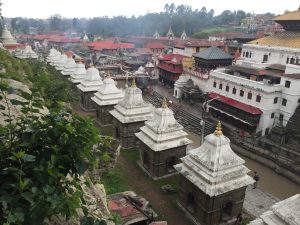Seismic Safety and Kathmandu’s Historic Urban Infrastructure, British Academy, GCRF, Cities and Infrastructure (£300K)
Kathmandu’s medieval cities and shrines are exceptional architectural and artistic achievements underpinned by traditions of seismic adaptation developed over centuries. They host urban infrastructure of tangible and intangible value and play vital roles of cohesion in the life of thousands and represent portals where the heavens touch earth and people commune with guiding deities. The earthquake was a human disaster, killing 9,000 people and displacing 2.8 million. It destroyed 500,000 homes and undermined the sustainability of Nepal’s tourist industry and its 400,000 employees. It was also a cultural catastrophe damaging 403 monuments in Kathmandu’s historic urban infrastructure (Gautam 2015).
This project builds upon previous British Academy-sponsored archaeological research at Pashupati, and within the wider urban environment of UNESCO, National Geographic and AHRC-GCRF sponsored rescue archaeology in post-earthquake Kathmandu, but now integrates archaeology and geoarchaeology with 3D visualisation and geotechnical and structural engineering.
More info at: Reducing Disaster to Life and Livelihoods by Evaluating the Seismic Safety of Kathmandu’s Historic Urban Infrastructure.


Figure 1. Photos from Pashupati region
Disaster Risk Reduction of Heritage Structures in Nepal, EPSRC, Global Challenge Research Fund – GCRF, (£20K)
Among the most devastating natural disasters experienced by Nepal was the recent 2015 earthquake, which caused heavy loss of human life, buildings and infrastructure. More than 9,000 people lost their lives, and around were 22,000 injured. Reports indicate that 604,930 residential buildings were completely destroyed and 288,856 were partially damaged.
Aligned with the UN Sustainable Development Goal 11.4 “Strengthen efforts to protect and safeguard the world’s cultural and natural heritage” and Nepal’s national strategy for disaster risk management (2009), this Newcastle University institutional project aims to adopt state-of-the-art facilities and approaches for the development of a risk based analysis tool to support the decision making process on heritage protection and management to natural disasters. In the long term, this will contribute directly to the recovery of local people’s livelihoods and the revitalization of economic development.
More info at: Disaster Risk Reduction of Heritage Structures in Nepal


Figure 2. Reconstruction at the Kathmandu historical valley
